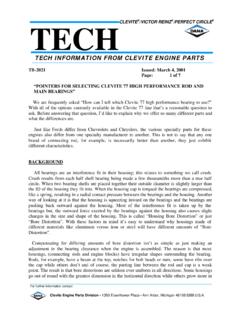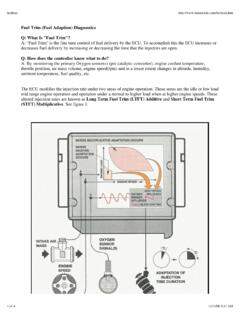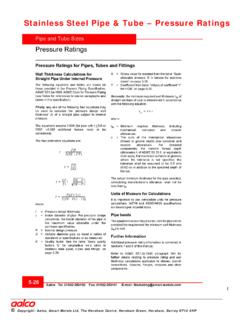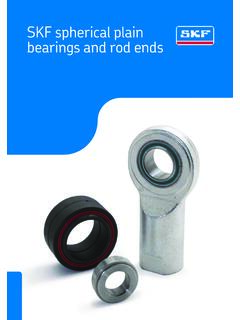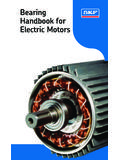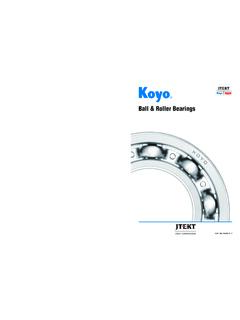Transcription of TECH INFORMATION FROM CLEVITE ENGINE PARTS
1 CLEVITE /VICTOR REINZ /PERFECT CIRCLE . TECH. TECH INFORMATION FROM CLEVITE ENGINE PARTS . TB-2021 Issued: March 4, 2001. Page: 1 of 7. POINTERS FOR SELECTING CLEVITE 77 HIGH PERFORMANCE ROD AND. MAIN BEARINGS . We are frequently asked How can I tell which CLEVITE 77 high performance bearing to use? . With all of the options currently available in the CLEVITE 77 line that's a reasonable question to ask. Before answering that question, I'd like to explain why we offer so many different PARTS and what the differences are. Just like Fords differ from Chevrolets and Chryslers, the various specialty PARTS for these engines also differ from one specialty manufacturer to another. This is not to say that any one brand of connecting rod, for example, is necessarily better than another, they just exhibit different characteristics. BACKGROUND. All bearings are an interference fit in their housing; this relates to something we call crush. Crush results from each half shell bearing being made a few thousandths more than a true half circle.
2 When two bearing shells are placed together their outside diameter is slightly larger than the ID of the housing they fit into. When the housing cap is torqued the bearings are compressed, like a spring, resulting in a radial contact pressure between the bearings and the housing. Another way of looking at it is that the housing is squeezing inward on the bearings and the bearings are pushing back outward against the housing. Most of the interference fit is taken up by the bearings but, the outward force exerted by the bearings against the housing also causes slight changes in the size and shape of the housing. This is called Housing Bore Distortion or just Bore Distortion . With these factors in mind it's easy to understand why housings made of different materials like aluminum versus iron or steel will have different amounts of Bore Distortion . Compensating for differing amounts of bore distortion isn't as simple as just making an adjustment in the bearing clearance when the ENGINE is assembled.
3 The reason is that most housings, (connecting rods and ENGINE blocks) have irregular shapes surrounding the bearing . Rods, for example, have a beam at the top, notches for bolt heads or nuts, some have ribs over the cap while others don't and of course, the parting line between the rod and cap is a weak point. The result is that bore distortions are seldom ever uniform in all directions. Some housings go out of round with the greatest dimension in the horizontal direction while others grow more in For further INFORMATION contact : CLEVITE ENGINE PARTS Division 1350 Eisenhower Place Ann Arbor, Michigan 48108-3388 the vertical. Still others may bulge where there's a notch for bolt head clearance. All of these bore distortion characteristics relate to the static loads between the bearings and housing when the ENGINE is not running. Still another consideration is what happens under the dynamic conditions of a running ENGINE where loads are constantly changing in magnitude and direction.
4 ENGINE loads placed on the bearings and their housings will result in still further changes in housing bore geometry. Original equipment bearings are tailored to compensate for the comb ined static and dynamic distortions, which occur in the housings. Specialty high performance PARTS like connecting rods and aluminum blocks are made for lighter weight and to withstand the higher loads and speeds of high performance engines. They seldom ever duplicate the bore distortion characteristics of the original equipment PARTS . Taking these facts into account it should come as no surprise then that standard passenger car bearings are not suitable for engines modified extensively to produce higher horsepower and speeds. This not only explains why we have special bearings for high performance but also why we offer several choices. With so many different specialty high performance connecting rods and blocks available, it's impossible for the bearing manufacturer to know the characteristics of every piece.
5 Even if we did the choices of related PARTS , which influence such things as rotating and reciprocating weights and balancing all effect bearing loads and consequently dynamic bore distortions. bearing DESIGN. So just how are bearings tailored to compensate for bore distortions? To understand this important design concern we must first determine what the most desirable shape for a bearing ID. is. If everything remained constant like loading, speeds and housing geometry, a perfectly round bearing could be made to work very well. For example, electric motor bushings run almost indefinitely under these conditions. In an ENGINE where we have the variables described above, it has been determined that a slightly oval bearing ID with the minimum diameter oriented in line with the maximum load is the most desirable. To produce this type of profile bearings are made with what we call an eccentric wall. In nearly all cases the bearing wall is thickest at 90 degrees to the parting line and tapers off from that point toward each parting line by some specified amount.
6 The amount of change, called eccentricity, is tailored to suit the bore displacement characteristics of the housing. A housing which experiences its greatest distortion in the horizontal direction (across the parting line) provides the desired oval shape so the bearing requires a minimum amount of eccentricity. If the housing experiences its maximum distortion in the vertical direction, a high eccentricity bearing is needed to compensate for this and produce the desired maximum ovality in the horizontal direction. Connecting rods are subjected to high inertia loads at the top of the exhaust stroke when the weight of the piston, rings, wrist pin and top end of the rod are all pulling on the rod cap. This loading tries to stretch the rod and pulls the big end out of round causing it to close in across the parting line. In this case bearing wall eccentricity provides extra clearance to let the rod flex without having the bearings contact the shaft. Besides by, medium and high eccentricity, CLEVITE 77 high performance bearings are offered with numerous additional features to make them compatible with related PARTS and suitable f or the loads and speeds of competition engines.
7 bearing FEATURES. All bearings stamped CLEVITE 77 are constructed of trimetal cast copper lead. These bearings have a steel back for support, a cast copper lead lining to withstand the loads of ENGINE operation and an electroplated Babbitt overlay on the running surface to provide searing surface qualities. The CLEVITE 77 marking alone does not necessarily mean the bearing is optimum for high performance. We make CLEVITE 77 bearings for passenger cars too. All high performance bearings are cataloged separately in a section at the front of the CLEVITE 77 bearing catalog. P Series . These are not to be confused with the standard passenger car and light truck PARTS for the same applications, which also have a P suffix letter. These high performance PARTS have unique core part numbers different from the standard PARTS for the same application. P series PARTS are the oldest series of CLEVITE 77 high performance bearings. The rod bearings in this series typically have the greatest amount of eccentricity.
8 Most rod bearings are available either with or without dowel holes for use in aluminum rods. Most P series main sets are full grooved to maximize oil flow to the rod bearings. Both rods and mains have high crush for maximum retention and a reduced overlay thickness to prevent overlay fatigue sometimes referred to as hen tracking. Rod bearings use hardened steel back for added strength and resistance to fretting. Extra clearance rod bearings are available for .001 additional clearance and select fitting. Use the P series rods where extremely high RPM'S cause severe rod bore close in. This is typically indicated by nearly full parting line to parting line shaft contact with bearings having less eccentricity. Use P series mains where higher eccentricity is desired to narrow bearing contact patterns and to provide increased oiling to rod bearings. Rod bearing oil starvation is typically indicated by polishing and smearing of the bearing surface possibly accompanied by discoloration predominantly concentrated at the axial center of the bearings.
9 Deltawall P Series Bearings . Deltawall bearings are only available for the early and late small block Chevrolet connecting rods. These bearings incorporate a patented design which produces a tighter clearance in the upper or rod half bearing to spread firing loads over more of the bearing surface while providing greater clearance in the lower or cap half bearing to allow for rod bore close in and to maintain oil flow for cool running. The upper and lower bearing shells differ in centerline wall thickness by .002 . The upper is .001 thicker than a standard equal wall bearing and the lower is .001 . thinner than an equal wall design for the same application. Use Deltawall rod bearings in engines which operate over a broad range of RPM'S with only brief periods of operation at maximum RPM; such as engines running on road courses or short tracks where the ENGINE pulls hard through its mid range. H Series . These bearings are ident ified by a letter H in the part number suffix.
10 Part numbering is based on the same core number as the standard passenger car PARTS for the same application. These bearings were developed primarily for use in NASCAR type racing but are suitable for all types of competition engines. H series bearings have a medium level of eccentricity, high crush and rod bearings have a hardened steel back and thin overlay. These bearings also have enlarged chamfers for greater crankshaft fillet clearance and are made without flash plating for better seating. Bearings with .001 extra clearance are available for standard size shafts and carry the suffix HX (X = extra clearance). Rod bearings are available with or without dowel holes (HD = with, H = without), main bearings are available with standard 180 degrees upper half grooving and with full 360. degrees grooving (H = 180 degrees, HG = 360 degrees). Use H series bearings with crankshafts that have oversize fillets and where engines run in the medium to high RPM range. H series bearings should be used if contact patterns obtained with P.
